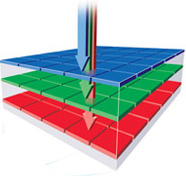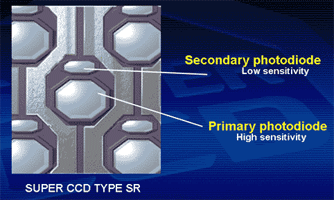Foveon X3
The company Foveon has developped a new CMOS based technology called X3. The Sigma SD9 and SD10 DSLR like the new Polaroid x530 digicam contain the foveon chips. As described in a previous page, the CMOS and CCS sensor record the colour by combining the complementary colour information of the neighboring pixels. On the X3 chip, a red, green and blue pixel is captured for each photosite (see figure 5), on a similar way as traditional films. This technology allows a very high cololur accuracy. Several tests performed with the Sigma SD9 and 10 have shown that these 3.4 Mo photosites (equivalent to 10.2 megapixels) perform almost as well as the 6 Mo CCD and CMOS DSLR (Canon 10D, Fuji S2 Pro, Nikon 100D). The density of the circuitry may be a problem for the development of sensor with a higher resolution, since it increases the background noise.
 |
Figure 5: On the X3 sensor, the light is successively capture by three silicon layers of different colours (blue, green and red), like on traditional films.
For more informations, www.foveon.com |
Fuju Super CCD
Instead of using square photosites, Fuji is using octogonal photosites organized in a honeycomb pattern as illustrated in figure 6. This result in a increase density of photosite on the sensor. Also , a small photodiode is added to the large photodiode in the latest Super CCD generation (the 4th). Small photodiode is designed to capture the high lights and the large one to capture the darkest details. I am waiting for the first tests of the Fuji FinePix S3 in low light situation to see if the increase of the dynamic range is not a trade-off with the background noise.
 |
Figure 6: Fuji (www.fujifilm.com) has developped a octogonal structure for the photodiode. On the new generation (the 4th), a second smaller photodiode has been added to increase the dynamic range of the sensor. The Fuji FinePix S3 pro is equipped with the new Super CCD 4th generation sensor. |
Hybrid ImagingTechnology
The Nasa is trying to develop a new technology, the Hybrid Imaging Technology (HIT), which consist in the combination of CMOS and CCD components into units that neither CCD or CMOS alone could provide. Matsushita (most know for its brand Panasonic) has manufactured the first sensor based on HIT (Feb. 2004). The power consumation is reduced by a 5 fold factor as compared to CCD sensors with a higher sensitivy than CMOS sensor (at the 1/1.8 sensor size). Mass production is scheduled for Q4 2004.